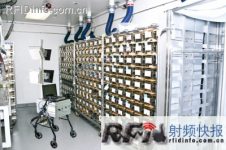
University of Florida laboratory uses RFID system to track mice
[ad_1]
The University of Florida laboratory is currently using an ultra-high frequency passive RFID animal cage system developed by Dynasys to track laboratory animals.
Laboratory animals are dangerous to a certain extent, and the effective tracking and management of these animals has important safety implications. In the original manual inspection mode, researchers needed to manually move the cages that housed the animals and inspected them one by one. Examining 50,000 guinea pigs would take days and be very error-prone. With the help of RFID systems, laboratory researchers can always know where the experimental animals are. Laboratory animals are closely related to scientific research projects, and laboratories often need to record and report massive amounts of experimental data to government departments or organizations that provide research funding. Careful care of laboratory animals can also save costs for the laboratory, so accurate daily records are very important.

RFID UHF system to track and release the cage of mice used in experiments

Mobile RFID reading and writing equipment
In response to this demand, the University of Florida laboratory specially allocated funds for the construction of RFID systems.
Judging from the current development of animal RFID applications, there are two main types of RFID animal tags that are most commonly used – RFID ear tags and implanted RFID chips, which are used to identify livestock and pets. In comparison, Dynasys’s RFID system has a relatively novel identification method. UHF RFID tags are hung on the cages of experimental animals instead of directly identifying the animals.

Implantable RFID chip for pet identification management

RFID ear tags for large livestock animal management
Implantable RFID chips are usually low-frequency, with short effective reading distance; and lack of effective anti-collision mechanism. That is to say, if the chip is implanted in a mouse, the mouse must be caught to read it.
Dynasys uses EPC Gen 2 UHF tags to identify animal cages. The reading distance, speed and anti-collision can meet the needs of the laboratory. In a few seconds, how many cages are stacked on the rack, and their respective What animal is obvious at a glance. Dynasys adopted the RFID inlay (inlay) produced by Texas Instruments, and carried out self-encapsulation, making it resistant to the interference of the metal cage. The RFID handheld and stationary reader devices are from Intermec; in addition, the system includes highly customized software.
Considering the adverse effects of RF signals generated by tags and readers on animals’ bodies or behaviors, Dynasys conducted a series of verifications and conducted related experiments on the blood pressure of mice. Currently, Dynasys’ RFID system is tracking and managing 3,000-50,000 laboratory animals. It is said that the system can meet the needs of laboratory management of up to half a million animals.
[ad_2]



